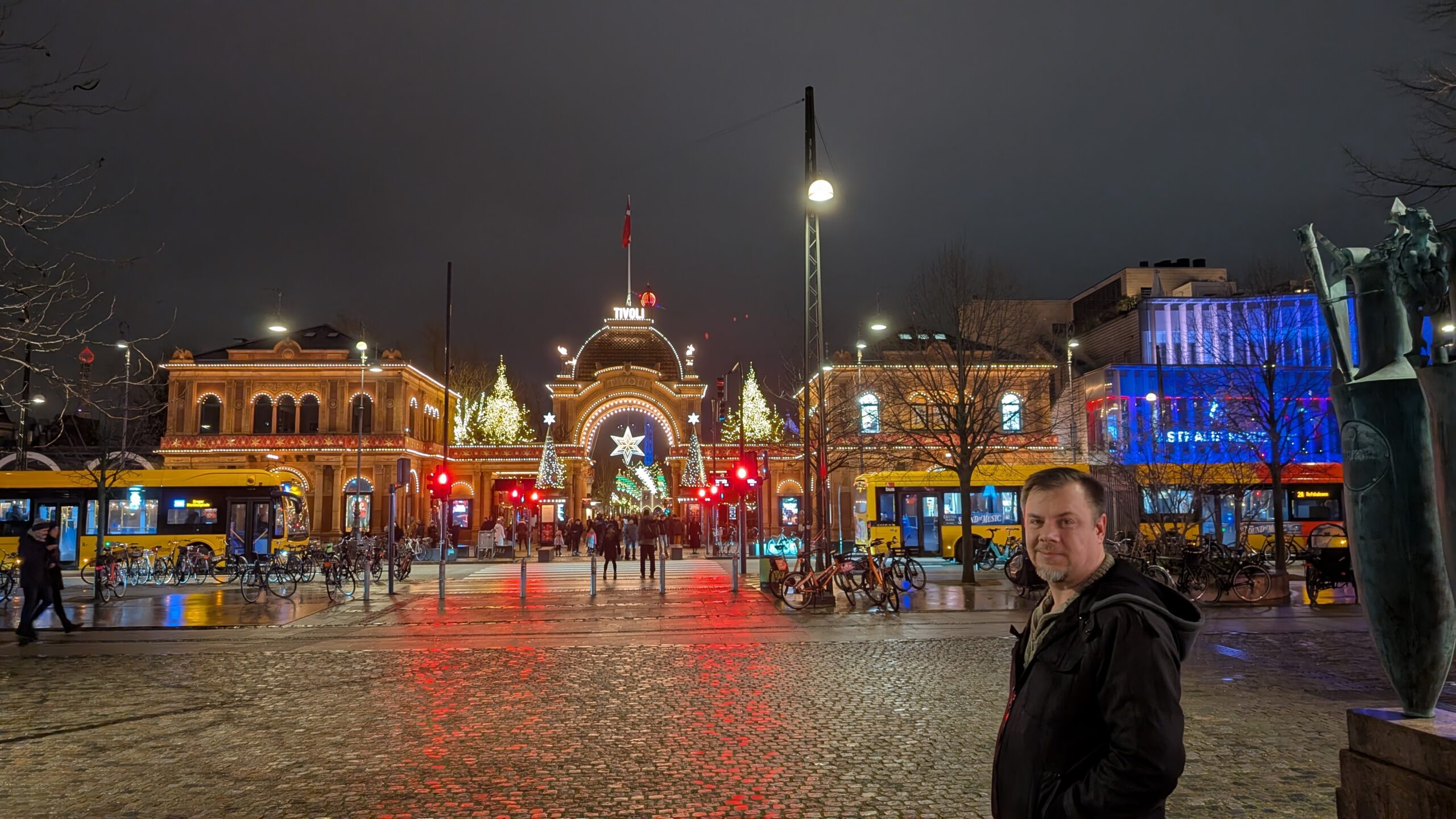Our grand tour of Northern Europe brought us to Denmark just in time for the magical stretch between Christmas and New Year. Denmark was country number eight on our adventure. We were nearing the grand finale of our journey. Stepping off the plane, we landed in a sleek, spotless airport before heading down to catch the train into the city centre. This train also zips over to Malmö, Sweden. So even though it arrives every ten minutes, you’ve got to double-check you’re on the right one!
Train Transfer
The train departs from Terminal 3 and costs 36DKK (about A$8). Grab your ticket from the red machines—just switch the language to English for an easy purchase. In just 20 minutes, we arrived at the central København station. This is a charming timber structure right next to Tivoli Gardens and conveniently close to our hotel. A quick ten-minute walk later, and we were checking in, ready to explore!




Copenhagen, like many European cities, was packed with electric cars, and charging stations seemed to be everywhere. But what really stood out was the sheer number of bicycles. They were parked in every nook and cranny and zipping by in dedicated bike lanes. You definitely need to look both ways to avoid a close call! Interestingly, helmets aren’t compulsory, so most riders go without them. Many hotels even offer their own branded bikes for rent, making it easy to join the two-wheeled frenzy.
Walking
Copenhagen’s flat landscape made it perfect for exploring on foot. The weather was chilly but stayed just above freezing, and the city buzzed with people. Unfortunately, we missed the Christmas markets, and workers were already dismantling the festive decorations and trees. At Rådhuspladsen, right across from City Hall, a giant digital thermometer caught our eye. It was hard to believe that temperatures here can drop as low as -20°C!
Just off City Hall Square, we stepped into Ripley’s Believe It or Not, which then led us straight into the Hans Christian Andersen Experience. Unfortunately, Ripley’s felt like it could have been anywhere in the world—worn-out displays, simple animatronics, and basic sound effects left us a bit underwhelmed. While it was mildly entertaining to walk through, it definitely wasn’t a highlight of our trip.
The Hans Christian Andersen Experience featured a series of alcoves, each bringing one of his famous tales to life, along with a small section about his life. Some of the story displays were incredibly clever and well-designed—Bianca absolutely loved them! However, if you’re not keen on standing around to read the stories or listening to them being told (at a very slow pace), it might not hold your attention. On the plus side, all the signs and stories were available in multiple languages.




We strolled down Strøget, the bustling pedestrian street lined with the usual city shops—plus an unexpected obsession with rubber ducks! We couldn’t help but laugh at the several stores dedicated entirely to them, featuring ducks in every pose and costume imaginable. It was bizarre, quirky, and oddly fascinating!



At Gammeltorv, we turned toward the canals to check out Copenhagen Castle and the Royal Palace. (Read more about our visit to Christiansborg Slot here!) It was fascinating to see the Royal Palace right in the heart of the city, but what stood out even more was the deliberate removal of Copenhagen’s old city walls. Unlike other European cities where the fortifications are major attractions, there’s barely a trace of them here. It felt like a bit of a missed opportunity, especially after visiting so many places where city walls played a key role in their charm and history.
Nyhavn Canal
We made our way to Nyhavn, a picturesque canal lined with vibrant, brightly coloured houses. Nearly every building seemed to host a restaurant, with cosy outdoor tables spilling onto the dockside. Arriving right at dusk, we managed to snap some stunning photos, though it was still a bit too early for dinner. Instead, we took a leisurely stroll along the waterfront and warmed up with a cup of Gløgg, soaking in the charming atmosphere.




We wandered up to Kongens Nytorv, where a large circular ice rink had been set up around the statues. It seemed like half of Copenhagen had turned out to skate. Most locals had their own skates and glided effortlessly across the ice at impressive speeds. Watching them was entertaining enough for us, though. We happily passed on renting skates and risking a few extra broken bones!
Exploring Copenhagen, the Meatpacking District and Vesterbro
Close by, we found the brilliantly lit Magasin du Nord department store, which we popped into—partly to warm up and partly to take a shortcut back to Strøget on our way to the hotel.
The next day, we set off to explore the vibrant Meatpacking District and the cool neighbourhood of Vesterbro.




From the outside, the Meatpacking District looks like it is – a collection of low, industrial sheds that once housed the meat industry. Some buildings even seem temporary, or are just rows of warehouses or docks. But the Danish have transformed this area into a vibrant, lively spot. Most of the buildings have been converted into trendy bars and eclectic restaurants. When we visited, a DJ was blasting music at 11am, and people were already out having fun and enjoying ice cream. It had an amazing energy!




Vesterbro, or “the west gate,” has earned a reputation as a cool, up-and-coming neighbourhood. It was once known for its strip clubs and sex shops—and a few of those still linger. Today, the area is full of stunning architecture, and we had a blast simply wandering the streets.
At the northern end of Vesterbro, just outside the train station and opposite Tivoli, you’ll find John’s Hotdog Deli. It’s a small van that’s become a must-visit spot for street food lovers. The place is so popular that even though the hotdog stand set up right next to it has almost no line, people were happily queuing for a fresh sausage from John’s. It’s clearly the real deal!







